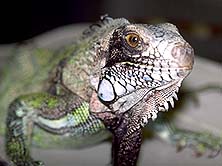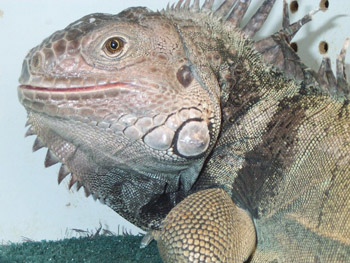The Green Iguana
Pet Qualities
The green iguana seems to possess an intelligence not usually seen among reptiles. Iguanas can become quite tame and often will interact with their owners. Often, they're content to ride around on their owners' shoulders, and appear to delight in being rubbed or scratched gently. Iguanas won't, however, return affection in the way of nuzzling or cuddling. But they do tend to learn household routines, and will know when it is mealtime, bedtime or time to go outside. Iguanas are often happy to perch on the back of the sofa or curtain rod, surveying the goings-on in the home.
A tame iguana will allow itself to be picked up and held without struggling, scratching, tail whipping or biting. Most iguanas seem to be able to identify individual people, and will react quite differently with their owners than with strangers. While an iguana may allow itself to be handled by its owner, the tame lizard may not take kindly to being held by a stranger.
Because iguanas benefit greatly from direct unfiltered sunlight, taking your iguana outdoors for some supervised time in the sun is an excellent idea. Once an iguana has heated up, however, it becomes more alert and active and may bolt away from its owner. There are several different kinds of harnesses available, and if your iguana will tolerate one they're a great method of restraint.

Green iguanas are great pets for folks living in apartments, condos and townhouses. They are very quiet and rarely destructive. Their exotic appearance is very appealing to people with a taste for the unusual. Iguanas are not difficult to maintain as long as their physical needs are met adequately. However, meeting these physical needs: light, heat, and nutrition can be challenging for a new owner. Please discuss any question you have with a veterinarian.
Cage and Substrate
There are many suitable ways to house an iguana. Our advice to owners of new hatchlings is to buy or build the largest cage they can accommodate. Many owners start out by purchasing a glass aquarium. Unfortunately, even a 20-30 gallon tank will be rapidly outgrown by a robust lizard. Another problem with glass is that they are heavy and cumbersome to clean. However, it is easier to control and maintain the correct temperature for a hatchling if it is kept in a glass or plastic tank for the first few months.
A cage can be a simple structure, or it can be designed and constructed to complement any decor. Pet stores can sometimes order custom-built cages, and some custom cages are advertised in reptile magazines. Cages may have a wood frame, or frames can be constructed out of aluminum. Plexiglas or soft plastic mesh can be used to enclose the cage. Cages should be designed (or purchased) with ease of cleaning in mind. Because iguanas are arboreal, cages should be tall enough to allow them to climb. Cages should be at least two times the length of the iguana and as deep as the iguana is long.
The cage bottom should be lined with an absorbent material to facilitate cleaning. Newspaper or butcher paper is convenient, but paper is not always the most aesthetical choice. Other substrates choices are orchid bark, alfalfa rabbit pellets, pine shavings, plastic turf or indoor/outdoor carpeting. If carpeting or artificial turf are used, make sure that the iguana cannot eat the material. Some carpets tend to unravel; strands can be dangerous if ingested. Substrate material, such as gravel, corn cob bedding, crushed walnut shells or sand should never be used, because iguanas may ingest them, resulting in impaction or other gastrointestinal problems. Another substrate that should never be used is cedar shavings (the oil is toxic). Some iguanas tend to defecate in the same place every time, which makes clean up easier. Clean the cage regularly. Some iguanas do tend to relieve themselves in water, so by removing the animals from their cages and soaking them frequently, cleanup can be simplified.

Branches and basking areas should be provided. Shelves are often appreciated for lounging. A hide box should be available to the iguana where it can get out of view and feel secure. The hide box should be in a warm area of the cage. Live plants may be used for decoration and to provide a more natural setting. Be sure to choose nontoxic plants, because the iguana is sure to taste them. Silk plants are a poor choice since iguanas cannot distinguish between live and artificial and often try to ingest them.
Heat and Light
Iguanas, like all ectotherms, thermoregulate by moving toward or away from heat sources and temperature zones, and engage in basking. Each species of reptile has its own Preferred Optimal Temperature Zone (POTZ). An iguana must reach the POTZ for correct digestion, growth, reproduction, healing and for the proper functioning of the immune system. Wild iguanas derive their heat from above, from basking in the sun not from lying on rocks heated from the sun. It is best to provide your iguana with a full-spectrum, incandescent light bulb for basking. Hot rocks, or other methods for heating an iguana on the abdomen, are not the best choices. Iguanas also need ultraviolet light. Make sure that the lizard does not have direct access to the light bulb, but provide an area where it can bask close to the light. Purchase a fluorescent light designed for reptiles. Place it in the cage in a way that the light is not filtered through glass, plastic or tight weave screen. Ultraviolet light is necessary for the proper absorption of calcium. Lights should be turned on for 12 hours, then off for 12 hours. It is important to realize that there is no perfect artificial light that can replace natural sunlight.
To create a thermal gradient indoors, place a source of substrate heat (tape pads or rocks) and an incandescent light bulb in a reflector on one side of the cage. Place a couple of thermometers in different areas of the cage to measure temperature in different zones. During the day, the hottest temperature zone in the cage should be around 98.5 degrees Fahrenheit, and the lower zone should be 80 degrees Fahrenheit. With this range of temperature, a healthy iguana will be able to maintain its body temperature at the correct level for proper internal functioning. In addition to lighting, a ceramic heater that screws into a regular light socket is an excellent addition to the cage to provide heat, but no light, for cool nights when supplemental heat is needed. Substrate heaters should be left on 24 hours per day, but all light bulbs should be turned off at night. At night you are shooting for a 10 to 15 degree drop from daytime temperatures.
The last consideration regarding heat and light is ventilation. There should be adequate ventilation and circulation of air in the cage to prevent high humidity that will encourage the growth of pathogens. Humidity should be in the 50 to 70 percent range.
Diet and Nutrition
Iguanas are vegetarians, specifically folivores. Folivores eat leaves primarily. They are hindgut fermenters, and to correctly process their food, they do require high environmental temperatures. Older books describe hatchling iguanas as insectivores that become herbivores as they mature. Although this is incorrect, it does not mean that a pet will not develop a taste for inappropriate food items. Feeding an iguana anything but vegetable matter or commercially prepared iguana diets should be strictly forbidden.
Hatchlings up to 14 inches should be fed finely chopped food twice daily. Juveniles up to 3 feet in length should be fed fine to medium chopped food once daily. Adults over 2 1/2 years of age or over 3 feet in length can be fed coarsely chopped food every other day. All plant material should be washed and chopped in a food processor to thoroughly mix the ingredients and prevent the iguana from selecting specific items.
Approximately 50 to 60 percent of the diet should consist of dark-green leafy veggies. Choose at least two of these: collard greens, turnip greens, mustard greens, bok choy, Swiss chard, dandelions greens, escarole, parsley and alfalfa pellets. Beet greens and spinach contain oxalates that bind calcium, so these greens should only be offered occasionally. Kale, Brussel sprouts, broccoli, cabbage, and cauliflower bind with iodine and should be offered sparingly. Approximately 30 to 40 percent of the diet should be chosen from this list: frozen mixed vegetables, squash, sprouts, carrots, cooked sweet potato, green and red peppers, peas, beans, corn, and green beans. Fruits should make up to 10 to 15 percent of the diet and may include papayas, mangos, apples, peaches, pears, plums, strawberries, bananas with the skin, tomatoes, grapes, kiwi, blueberries and guavas. Whole grain breads and natural bran cereals can be offered in moderation. In place of grains, commercially prepared iguana food can be a nutritious part of the diet. Iguanas often enjoy hibiscus flowers and leaves, rose petals, geraniums, nasturtiums, squash blossoms and carnations. These can be offered for variety but should not be fed daily.
Most iguanas obtain water through the water content in the foods they eat, so many won't drink from a dish or tub. If a commercial diet is fed, keep in mind that most are fed dry, which will decrease the lizard's water intake. It may be better to feed a canned moist food or to moisten the dry diet prior to feeding.
Live food is not necessary for green iguanas. Some enjoy crickets or pinkie mice, but these sources of animal protein are poor dietary items for this species.

Handling Hints
Iguanas should never be picked up by the tail. The tail of a young iguana may break off. The tail will regenerate, but will not grow back as long or as brightly colored as the original.
Encircle hatchling iguanas gently with your hand to prevent them from darting free. Larger iguanas should be held so the whole body is supported. This makes them feel more secure. Don't pick up iguanas by their limbs; this can cause injury.
Frightened iguanas may try to bite or scratch. Bites from large specimens can be quite painful and inflict serious wounds. Scratches can hurt, and a whip from the scaly, powerful tail can raise a welt. You may want to consider having your iguana's nails clipped periodically.
Zoonotic Diseases and Precautions
Green iguanas can harbor bacteria that can cause disease in humans. One genus of bacteria, Salmonella, is most dangerous in immunosuppressed adults, infants, children and geriatrics. Tests for Salmonella can result in false negatives, so it's best to assume that all iguanas are potential carriers. To minimize risk of exposure, do not clean reptile equipment and supplies where food is prepared for humans. Do not share sinks and bathtubs to soak or clean tanks. Wash hands thoroughly after handling an iguana, and don't touch your face prior to washing with antibacterial soap. Do not allow young children to handle iguanas until they can understand the concept of correct handling and sanitation.
Pinworms and roundworms found occasionally in green iguanas are not transmissible to humans. Rarely, intestinal protozoa may be found in green iguanas that can be contagious to humans.
Bathtubs, sinks or other areas where the iguana has been should be disinfected with bleach solution (1/2 cup to one gallon water). Be sure to rinse well after bleaching.
[ Search Articles ] [ Article Index ]
